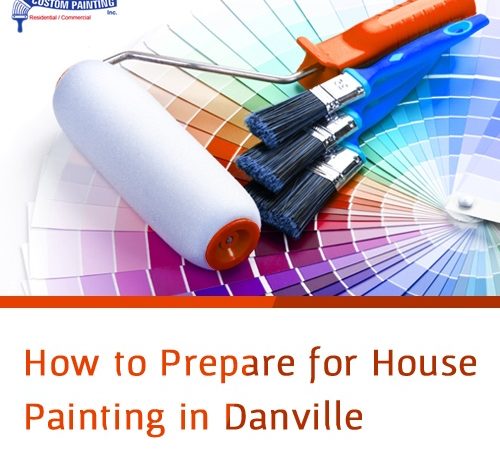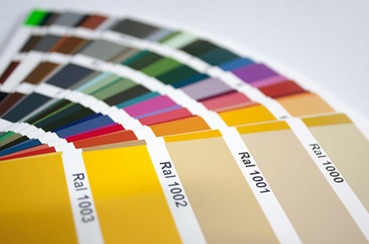
Whether you do interior or exterior house painting in Danville, preparation is always the key to a good paint finish. This is the mantra of the pros, and something that the DIY-ers should be aware of, as well.
If you are planning a house painting project, never, ever skip the prepping part. We know that you are excited to proceed to the painting part, but you cannot paint well (and effectively) without going through prepping. Always remember that a dirty or damaged surface is no guarantee for a good paint finish.
For prepping indoor surfaces:
1. Be sure to make the space clear as possible. Remove all furniture and other items out of the room. If you cannot move them out, cover them with drop cloths.
2. Remove outlet and switch covers.
3. Wear old clothes (in case the paint drips or splatters), goggles, and face mask.
4. Dust and clean the walls. A damp rag will usually do, but for cleaning more stubborn dirt, use something heavier like a scrub brush.
5. When painting bathrooms and kitchens, wash the walls with the solution of about three teaspoons of detergent to a gallon of water. Be sure to rinse the walls to remove the cleaner before you begin painting.
6. If there’s any flaking or peeling old paint, scrape it off. Before scraping, if you live in a home built before 1978, you may want to test the paint to be sure it doesn’t contain lead. You may purchase lead tests at most home centers or possibly a local hardware store. Once the paint is confirmed to be lead-free, you can use a metal scraper to remove the paint. After scraping, use a sandpaper to smoothen the surface.
7. For surface flaws like small holes or cracks, fill them with a spackling compound or any good quality wood filler. To hasten the process, clean the excess compound while it’s still drying. Once dried, use a sanding sponge or a just simple damp sponge to smooth what is left of the compound.
8. Seal areas (such as trim or frames) you don’t want to paint with a painter’s tape. Use a plastic putty knife or even an old plastic gift card to remove the air and create a better adhesion between the tape and the surface. Never use a metal scraper as it makes obvious marks on the tape or could damage it.
9. Cover the floor with drop cloths to prevent it from being dripped or splattered with paint.
10. Create a paint station well away from the busiest part of the space. It should have all the necessary materials such as paint, paintbrushes, rollers, paint can opener, stirring sticks, rollers and roller covers, and paint trays if you use them.
11. Prime the surface, if necessary. Primer may not be necessary if the surface is in good shape, but using a primer can make the paint adhere better.
When it comes to the exterior surface, the manner and the degree of preparation depends on the type of the surface itself. Make sure though, that you thoroughly clean the surface — a virtually spotless surface enables more effective paint adhesion. Cover shrubs, flower beds, decks, and walkways to protect them from splattered paint.
1. New wood siding – Brush the surface clean, from the top down to the bottom. Prime or stain the surface, then caulk all joints.
2. Existing wood siding – If you see any flaking or loose paint, scrape it off. Then use ordinary sanding paper or a power sander to smoothen that particular area of the siding. Next, apply primer to any bare wood, and caulk all joints. Fill any small holes and cracks with caulk, spackling compound, or any other good wood filler. Finally, prime the siding.
3. Concrete, brick, and masonry – For a fully cured and unfinished concrete, clean it first (a power washer is recommended for this job), then stain or paint it.
For preparing brick or masonry, use a good masonry cleaner to remove dirt, dust, and grime. If there is loose paint on the brick or masonry, scrape it off so the surface is free of chipping paint. However, doing this so would dull the metal scraper or the sandpaper. You may consider other methods such as sandblasting or using chemicals to help remove the stubborn flaking paint.
If you find some noticeable holes, cracks or any fissures on the surface, clean them out before filling them with a caulk or any other good concrete filler. In doing this, you may lift the dirt off by using either a wet-dry vacuum or a compressed air.
4. Stucco – Remove the loose dirt by using a regular garden hose. If you decide to use a power washer, be extra careful as this method can damage the stucco and you may end up needing to repair it.
To get rid of the more stubborn dirt that remains in the smaller holes and crevices of the stucco use masonry cleaner. Finally, scrub it by using a stiff brush.
5. Bare metal – Iron or steel sidings and railings tend to rust over time. So before you paint them, make sure to remove the rust by sanding it off or by using a wire brush. Next, treat the iron or steel surface with a good quality rust remover or a rust inhibitor. Finally, apply a metal primer on the surface.
Prepping can take a lot of work. But this step is why professional house painters like Custom Painting, Inc. always end up with great results — they properly prepared the surface. Even if you’re a DIY-er, you will still be able to achieve the professional results as long as you don’t skimp on prepping when house painting in Danville.

